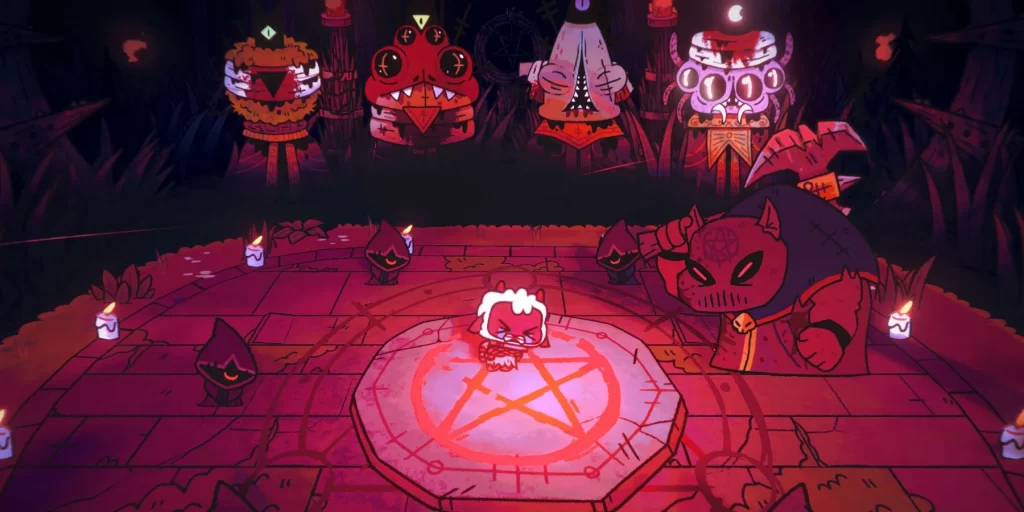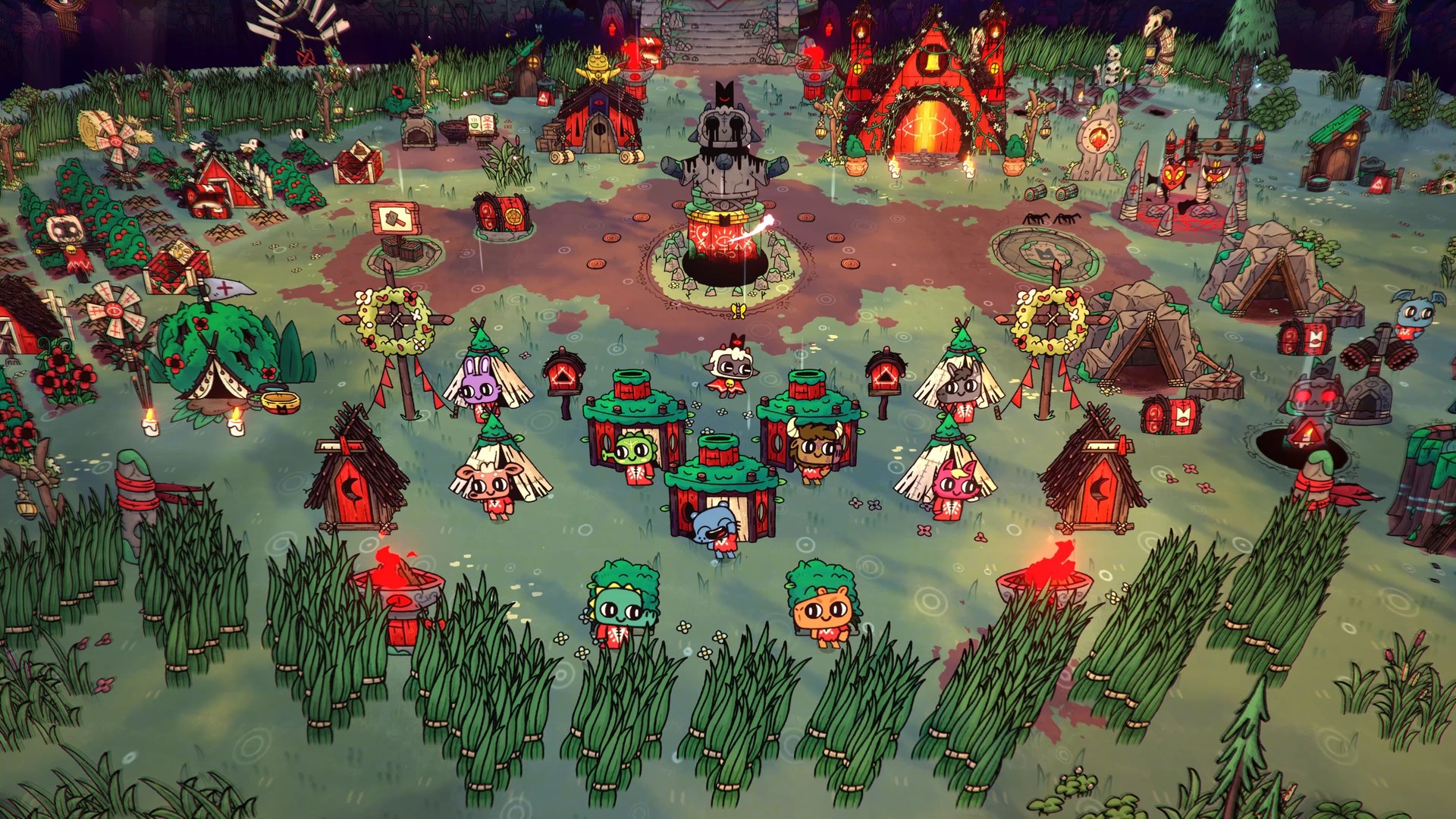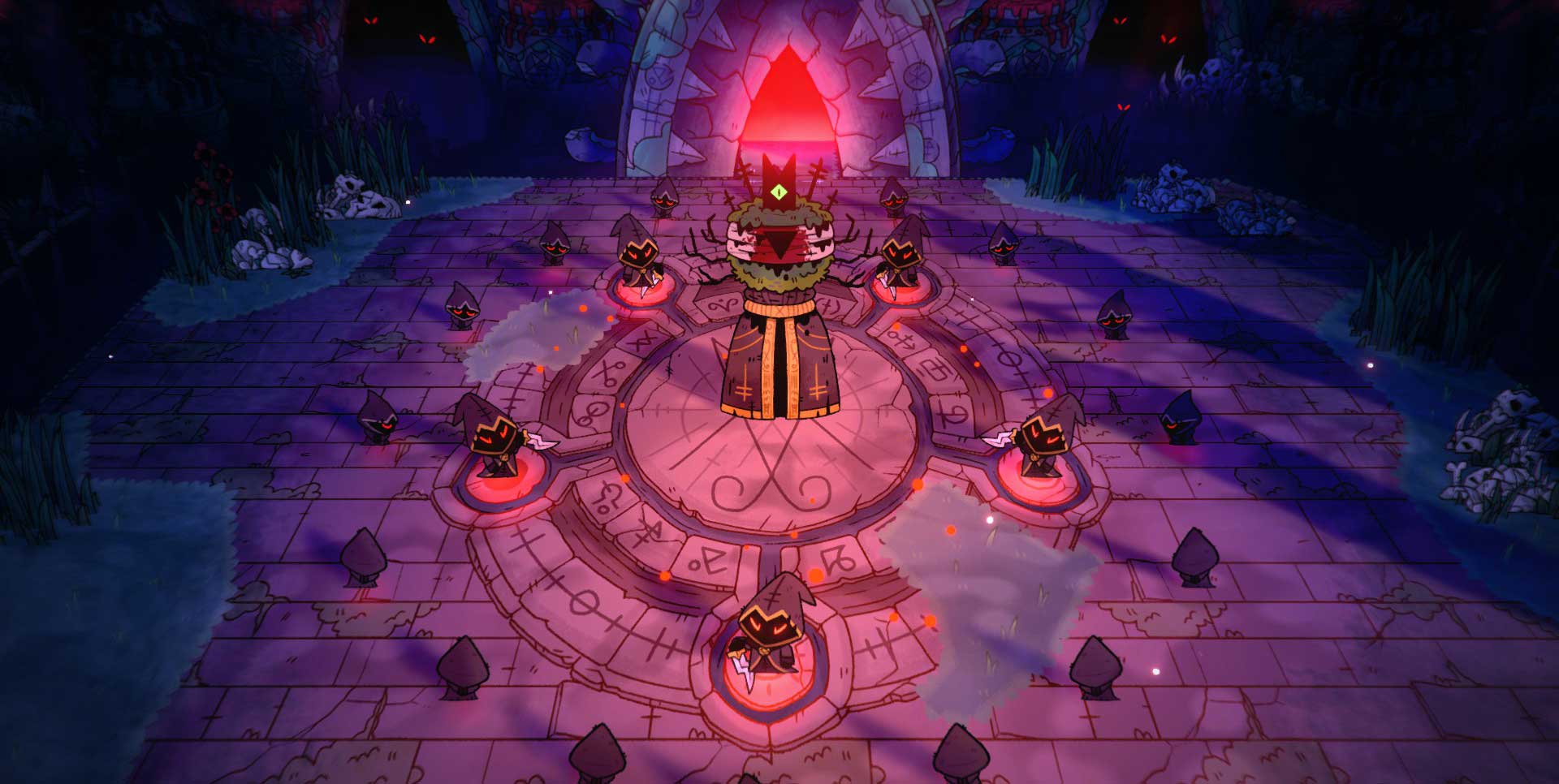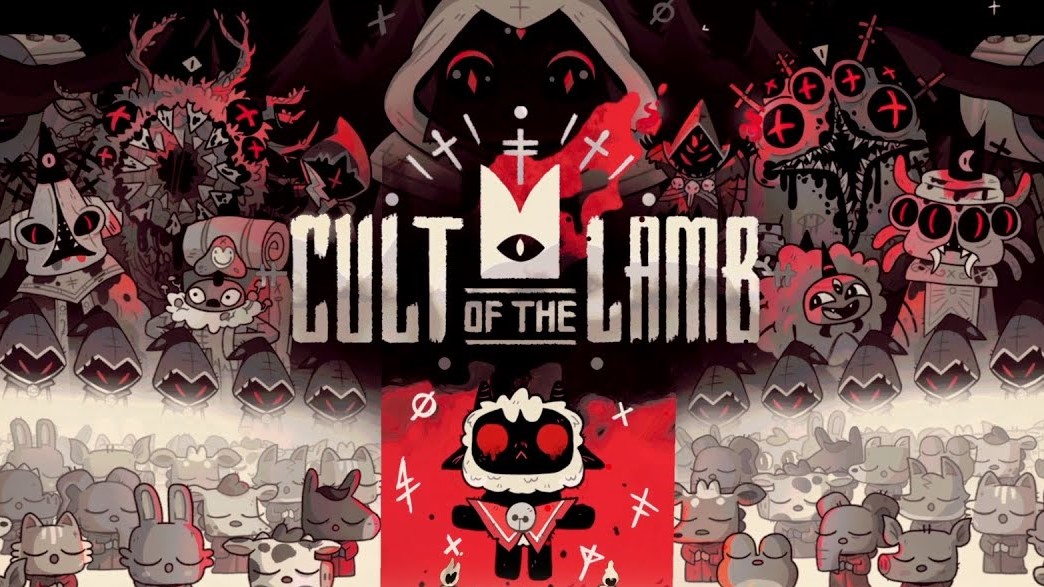Cult of the Lamb is a 2.5D action-adventure strategy indie game released by Australian studio Massive Monster Games on August 11th, 2022 on the Nintendo Switch, PC, PS4, and Xbox. Garnering massive attention before release, and gaining 1 million players in its release week, Cult of the Lamb has gained quite the cult following. Heh. A combination of a cutesy art style and outright gruesome subject matter are large factors in the game’s instant success. (Well, Massive Monster’s active Twitter and Discord probably helps.) Cult of the Lamb is both a survival sim and a dungeon crawler at once; the player, a sacrificial lamb turned cult leader to a deity dubbed “The One Who Waits,” travels a randomly generated world to fight and defeat non-believers, indoctrinate new followers, and ultimately work their way to defeat “The Four Bishops of Old Faith” – those who killed them in the first place. Afterwards, the cult leader returns to their “flock,” their titular cult, partaking in nail-biting resource management and trying to keep their cult fed, rested, and, of course, faithful. There’s no doubt that Cult of the Lamb’s signature art style is equal parts adorable, beautiful, and horrifying, but the game released with many bugs upon release in all ports, and the combat leaves something to be desired. Can this game, like a true cult leader, blind us to its flaws with sheer charisma?
Wolf in Cult’s Robing
-
Story & Lore - 6.5/10
6.5/10
-
Gameplay & Mechanics - 6/10
6/10
-
Graphics, Settings, Artstyle - 8.5/10
8.5/10
-
Soundtrack - 9/10
9/10
-
Replayability - 5/10
5/10
-
Overall Ranking - 7/10
7/10
Summary

Cult of the Lamb opens with a bang: in a world of anthropomorphic animals, you are the last lamb of your kind, and you are brought before four eldritch deities, referred to as “The Four Bishops of Old Faith.” Labeled a “heretic,” you are sacrificed to prevent the “prophecy” from being fulfilled. Instead of dying, you find yourself in front of a mysterious entity, “The One Who Waits.” The One saves you from dying and blesses you with powers, on one condition: create One True Cult in The One’s name. These newfound powers allow you to escape your captors, save a fellow sacrifice, and be guided forth by an ally named Ratau to the ruins of cult grounds. From here, it is your job, as thanks to The One Who Waits, to recruit new followers and create a great fanatical cult to praise The One’s name. It is not enough to be one great cult, however. You must be the only faith. Driven by this (and perhaps a thirst for revenge), you travel the lands to defeat the Bishops, one by one, indoctrinating new followers (whether by charm or force) and gathering resources for those already devoted. While much of Cult of the Lamb focuses on the titular cult, full of sometimes silly, sometimes cute, sometimes murderous animals with multiple different questlines, there are snippets of underlying lore that the player gets over the course of the game. With every battle, you not only learn of the Old Faith, which threatens your cult’s existence, but of the very deity you worship…and their true motives.
As previously mentioned, Cult of the Lamb offers an amalgamation resource management/strategy/survival/roguelike/action-adventure experience. The different mechanics go hand-in-hand: you must explore the randomly generated maps not only for bulk resources, which is needed to maintain your cult and their needs, but to grow the cult and indoctrinate new followers. For Cult of the Lamb’s gameplay, it’s best to talk about it via two categories: the Action and the Survival. Or, to expand on that, the combat mechanics and the resource management. The action of Cult of the Lamb, while initially feeling snappy with a smooth dodge button, becomes tedious very quickly. The controls themselves are simple, which in my opinion, isn’t a bad thing. However, when the Switch port in particular (which was my chosen console) lags with many loading screens and actions, it’s difficult to say I had fun while fighting, no matter how creative the monster designs were. To shake up the simple controls, the game offers various weapons and buffs, the latter of which have tarot-card themes. However, weapons for the ensuing area are not the player’s choice, which can add to the tedium if the RNG gods give you weapons that go against your preferred playstyle. To Massive Monster’s credit, they were quick to patch and update the game to fix these bugs, but even after their efforts, I don’t find myself engaged in combat with its limited features and lack of true upgrades – I’m often frustrated by it instead. Though the gruesome reds might lead one to believe Cult of the Lamb is combat focused, surprise of all surprises, the cult itself lies at the heart of Cult of the Lamb, and works as your primary mechanical progression through the game. When the player lamb brings back resources from their dark, violent journey, they return to the grounds of their steadily growing cult, formed of former sacrifices and former enemies alike. Indoctrinated followers can be put to work clearing out the initial mess, gathering resources like wood or stone, or devoting themselves to worship to gain a resource fittingly called devotion. The player lamb and the grounds have their own abilities and add-ons to unlock, including the previously mentioned weapons and new structures. The managing is incredibly difficult to get under control, especially in the beginning; Cult of the Lamb does not go easy on new players, for with a large cult comes many mouths to feed, too much poop to clean up, and eventual aging folks to potentially sacrifice. Be careful with the actions you take, though: your cult strengthens with the Faith of each follower, and weakens with all Faith lost. Faith can be lost through starvation, sickness, and often murder; if too much is lost, your once devoted followers will finally be disillusioned and disband. While sometimes a headache with how much micromanaging is required, Cult of the Lamb manages to have so much charm in the masses of followers, who can beg for food, murder, peace of mind, or even marriage, that it ultimately makes up for it.

One can’t talk about Cult of the Lamb without mentioning its artstyle. With a team of six artists, Cult of the Lamb is absolutely stunning, and certainly it’s biggest strength. The style is clean and cartoony, and every one of your anthropomorphic companions is absolutely adorable, even when committing heinous or violent crimes. Even so, the style is never truly unfitting with the contents of the game, in large part due to the sheer atmosphere. With color, lighting, and music working in tandem with intricate, yet simple art to create truly haunting environments, Cult of the Lamb manages to feel down to its very bones like a wolf in sheep’s clothing. Unfortunately, it’s difficult to appreciate these fine details due to previously mentioned performance issues; whether it is the high detail or not, my Switch seemed to lag regardless of graphical settings.

While it seems surprising, the soundtrack of Cult of the Lamb is another one of its strongest aspects. Composed by Narayana Johnson, who worked with Massive Monster on a previous game, Unicycle Giraffe, every track is intricately created with various instruments – drum beats, flutes, even choirs – and layers of sound. With music alone, Johnson manages to convey the upbeat nature of the loyal and cutesy followers with the sinister overtones of the subject matter, with one sometimes chosen over the other, or both combined. When you are on your cult grounds, it is upbeat and uplifting, as it should be for a cult leader visiting his flock. When you are in battle, the atmosphere is tense and pervading, aiding in your struggle to survive your encounters. Simply a treat for the ears, my favorite is one of the boss battle themes, Heket.
Cult of the Lamb, depending on your choices, can still continue after all bosses have been defeated, with options to battle bosses again in the same playthrough and the randomly generated maps allowing players to continue in their current save. There are multiple customization options within the cult itself that players can amuse themselves with, but in the end, once you experience the relatively simple (if intriguing) story of Cult of the Lamb, there isn’t much incentive to continue forward. And after the effort spent to build your cult up, it’s unlikely any sane player would want to start from scratch again. In short, while a fun experience, it doesn’t lend itself well to multiple playthroughs, though perhaps this will change if the developers decide to add rumored endgame content. To summarize, while only half of its gameplay truly hits the mark, making for, at times, a somewhat lackluster experience, one can’t deny the sheer presentation involved in Cult of the Lamb…hindered only by post-release lag and bugs. I was one of many people enthused for release, waiting with bated breath, but the magic did wear off fairly soon into my playthrough. I was enthralled by the world and imagery presented, but I can’t say I’d revisit Cult of the Lamb outside of an infrequent whim. The soundtrack, free on Youtube, is quickly becoming part of my regular playlists, though. I would still recommend trying it out yourself, with the caveat that it won’t be for everyone, and not only for the content involved. If a potentially frustrating game about cult-leading lambs and eldritch gods is for you, consider buying it on Steam!
(And Massive Monster blessed us with a free demo, for any nonbelievers.)
https://store.steampowered.com/app/1313140/Cult_of_the_Lamb/

Overall
7/10Pros
- Intriguing, if simple story
- Beautiful art
- Gorgeous music
Cons
- Flawed gameplay
- Performance issues
- Little replayability

